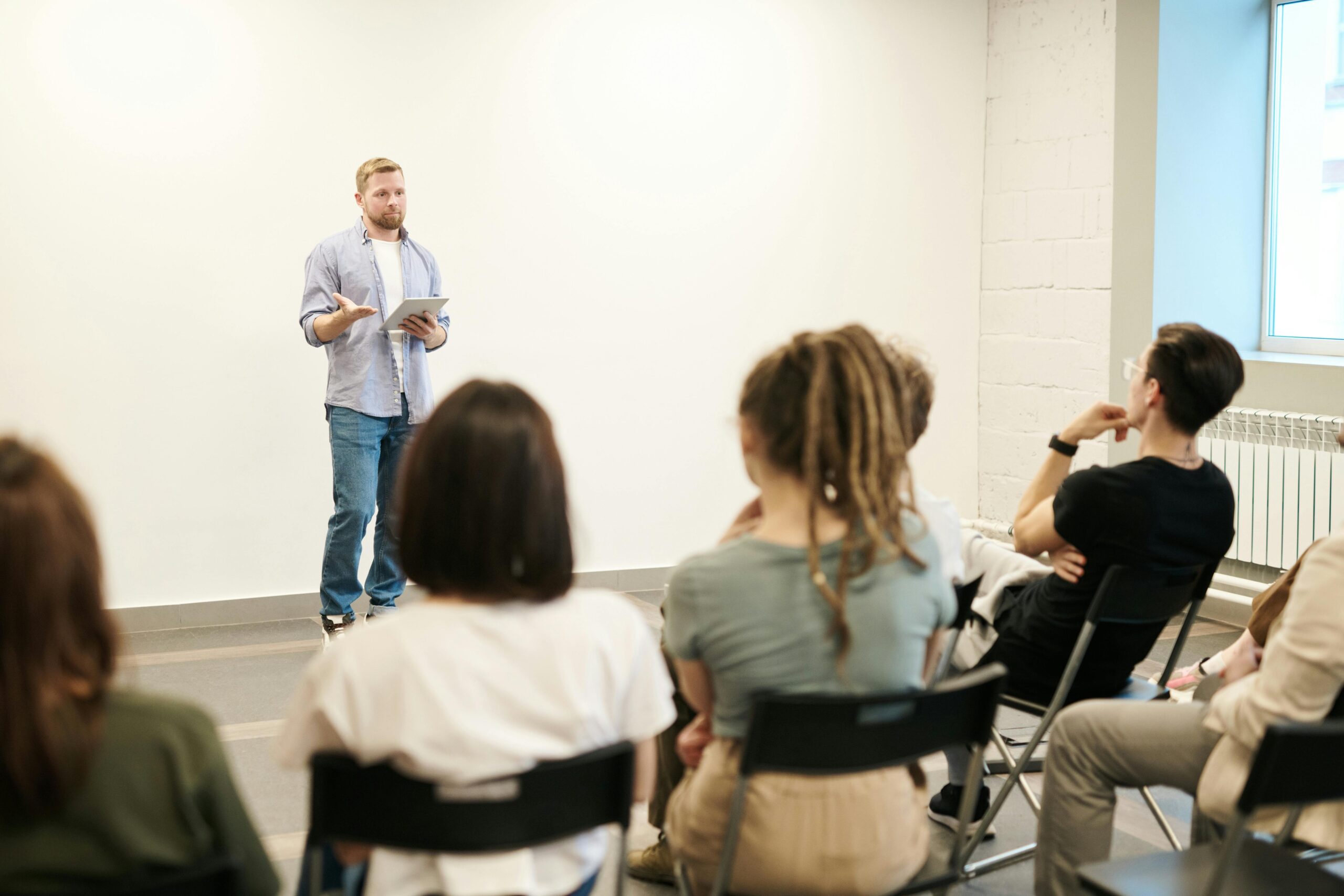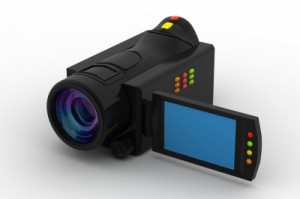In today’s business world, it is more important than ever to make a good impression on your co-workers, customers, and clients.
Whether you are introducing yourself to your new group members, giving a speech, or trying to sell your product, speaking to an audience is a very valuable skill and it extremely important in the current economic environment.
I’ve been teaching Presentations to businesspeople now for several years and I, myself, have spoken in front of audiences of around 50 people (and once performed a magic show!). Here are my top 10 tips to help you give an excellent presentation.
What are my tips for Giving Excellent Presentations in English?
Planning
Planning and preparation are extremely important in order to give a great presentation. Let’s start here with our first tip.
Tip #1: Identify Your Audience
Think about who will be in your audience and their level of knowledge as it relates to your topic.
• Are they experts in your field?
• Are they completely new to your ideas?
• Or are they a general audience made up of the public?
• Can you use slang terms or jargon?
• Or should you use simple terms to be effective?
A little time spent thinking about your audience could go a long way into making your presentation very effective.
Tip #2: Identify Your “Take-Home” Message
What is the one, most important thing or idea you want the audience to leave with after hearing your presentation? Most people have trouble remembering details or many points made in talks so your best approach to be effective with your message is to identify ONE specific point and make sure the audience understands it clearly.
Ex: Our product’s key benefit
Ex: One thing people can do to help solve world hunger
Ex: One idea to help people live a longer life
Introduction
This is where the audience will see you for the first time so you want to make a strong impression. Dress nicely and start by introducing yourself with confidence.
Tip #3: State Your Purpose in ONE Clear Sentence
After you introduce yourself, it is wise to let the audience know why you are speaking to them and why they should listen to your talk. This is NOT the time to use fancy vocabulary! Use simple and clear words that EVERYONE can understand in one sentence.
Ex: The purpose of my presentation today is to introduce you to our new product, the iPud.
Ex: I’m going to talk to you today about how we can solve the issue of world hunger.
Ex: I’m here today to share my research with you about living a longer life.
Tip #4: Catch the Audience’s Attention Quickly
Right in your introduction, you want to catch and hold the audience’s attention so they continue to watch and listen to the rest of your talk. If not, their minds may wander off and worse yet, maybe even fall asleep! So, in order to do this, you can use one of a few techniques:
• State a surprising fact (of course it must be true!)
• Tell an interesting story
• Ask a provocative question to the audience
• Make a joke
Ex: Actually, our team designed and built the first iPud in just 10 days! (surprising fact)
Ex: What if your salary was only $1 per day? How would you eat and where would you find food? (provocative question)
Ex: I recently visited the island of Okinawa, Japan to ask the local elders what they do to live a long life. Their reply was: “We don’t use a remote control for the TV. Instead we get out of our chair to change the channel.” (interesting story)
Tip #5: LIST Your Main Points
The key word in this tip is “list.” Please do NOT go into the details at this time. The purpose of listing your main points is to give the audience a plan or a map of how your presentation will go. This also creates anticipation for the later parts of your talk. Keep this brief, but don’t leave it out.
Ex: I’ve divided my presentation into three parts. First, I’ll talk about the history of the iPud. Next, I’ll discuss the main features of the iPud. And finally, I’ll highlight the key benefit of the iPud.
Main Body
This is the main section of your talk. Focus on delivering a clear message while trying to make eye contact with various members of the audience.
Tip #6: In Your Visual Aids, Use BIG Graphics and BIG Fonts
 Most of us these days use some type of software to assist with our presentations, namely PowerPoint for Windows and Keynote for Mac. If you use slides, keep your text to a minimum and use graphics as much as possible. The bigger the size, the bigger the impact. Avoid “reading” your slides because the audience will lose interest. If you don’t believe me, just ask Steve Jobs–one of the greatest presenters of all time. This is a tip straight from the master.
Most of us these days use some type of software to assist with our presentations, namely PowerPoint for Windows and Keynote for Mac. If you use slides, keep your text to a minimum and use graphics as much as possible. The bigger the size, the bigger the impact. Avoid “reading” your slides because the audience will lose interest. If you don’t believe me, just ask Steve Jobs–one of the greatest presenters of all time. This is a tip straight from the master.
Tip #7: Tell the Audience when you are Changing Points and PAUSE between Points
This is really important to help the audience know when you are moving on to your next point or topic. Even if you are using PowerPoint, you should also use your voice to help guide the audience along your agenda. Don’t race through your presentation! Pause between your major points and take a deep breath. This will help you relax as well as let the audience know that you are changing topics.
Ex: Let’s move on to my next point—the features of the iPud.
Ex: Next, I’d like to discuss the reasons why we need to solve world hunger by 2020.
Ex: So, let’s look at the final item on the agenda, which is “How to Eat Healthier.”
I’ve seen too many students give presentations where the speed right through all of their points and I can’t keep track of what they’re talking about. To be honest, I usually get lost and lose interest.
Conclusion
In my lessons, many times the students end their presentations suddenly after finishing their final point. In other words, there is no conclusion. Make sure you have a clear ending like the ending to a book or movie.
Tip #8: End with a Personal Message
In your conclusion, you will probably summarize your main points to wrap up. In addition to that, I suggest that you include a personal message to finish your presentation in a very strong way while also re-emphasizing your “take-home” message. Some of the methods you can use are:
• Give a Call to Action (a specific action you want the audience to take)
• Offer your Opinion
• Share a Quick Story or a Lesson you’ve Learned
Ex: In my opinion, I have to say that the iPud is the best electronic device ever put on this earth! (opinion)
Ex: So, to close, I’d like to ask all of you to donate some of your extra savings or volunteer some of your time to help local charities feed the hungry. (call to action)
Ex: After researching and interviewing the people who live the longest in the world, I’ve discovered that the true method to living a long life is to be happy everyday of your life. (lesson learned)
General Tips
Here are the final two tips to think about for your next presentation.
Tip #9: Practice the Way you want to Present For Real
In my lessons, my students usually ask me questions like,
• “Al, can I use my notes?”
• “Can I use the whiteboard?”
• “Do I have to memorize my whole presentation?”
My answer is the same to all of them. There are no rules in my lessons. My advice is to practice the way you will perform in a real situation. If you cannot use a whiteboard in your real presentation, it doesn’t make sense to use it for practice. If you want to use notes in the real situation, then use them for practice. Do whatever will help you the most in a real life presentation. Your lesson time is NOT a test, but instead an opportunity to speak in front of an audience and get valuable feedback. There are no “have to’s” or “must’s”.
Tip #10: Use a Video Camera to Record Yourself
We used to advise people to stand and practice in front of a mirror. However, I’d say using a video camera to record yourself is much better because you will act more naturally and you will be able to hear yourself and watch yourself from the perspective of an audience member. Be especially aware of your body language and voice projection. Are you making eye contact? Can the person at the far end of the room hear you? Make notes of the points you wish to improve and add them to your next practice session.
Tip #11: Let me hear from you!
I know I said “Top 10 Tips” but there are actually 11 here. So I want to hear your best tip! If you have a tip for giving effective presentations in English that you want to share, please add it to the “Leave a Reply” Box below!
Good luck!
Image courtesy of jscreationzs / FreeDigitalPhotos.net
Image courtesy of renjith krishnan / FreeDigitalPhotos.net


